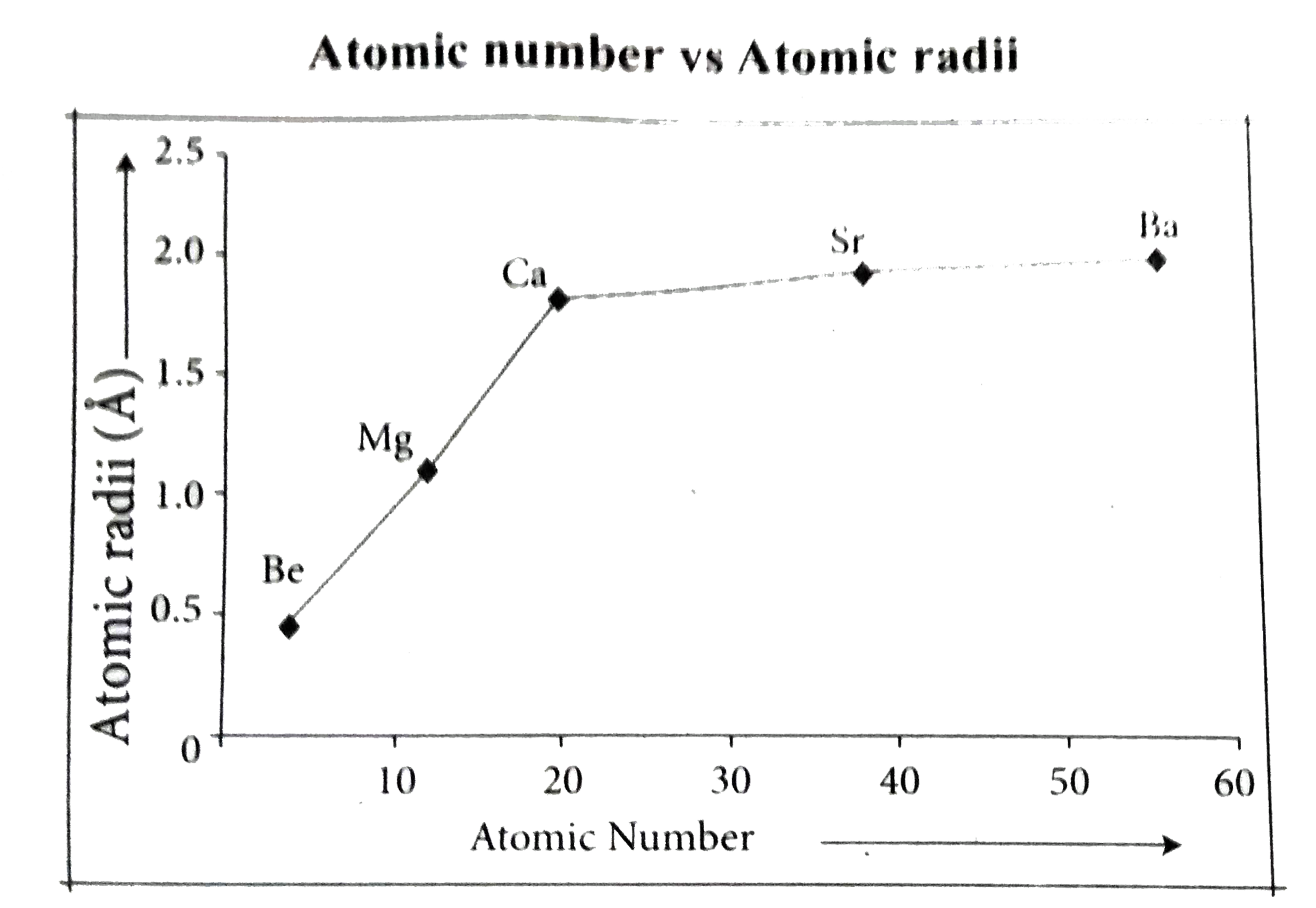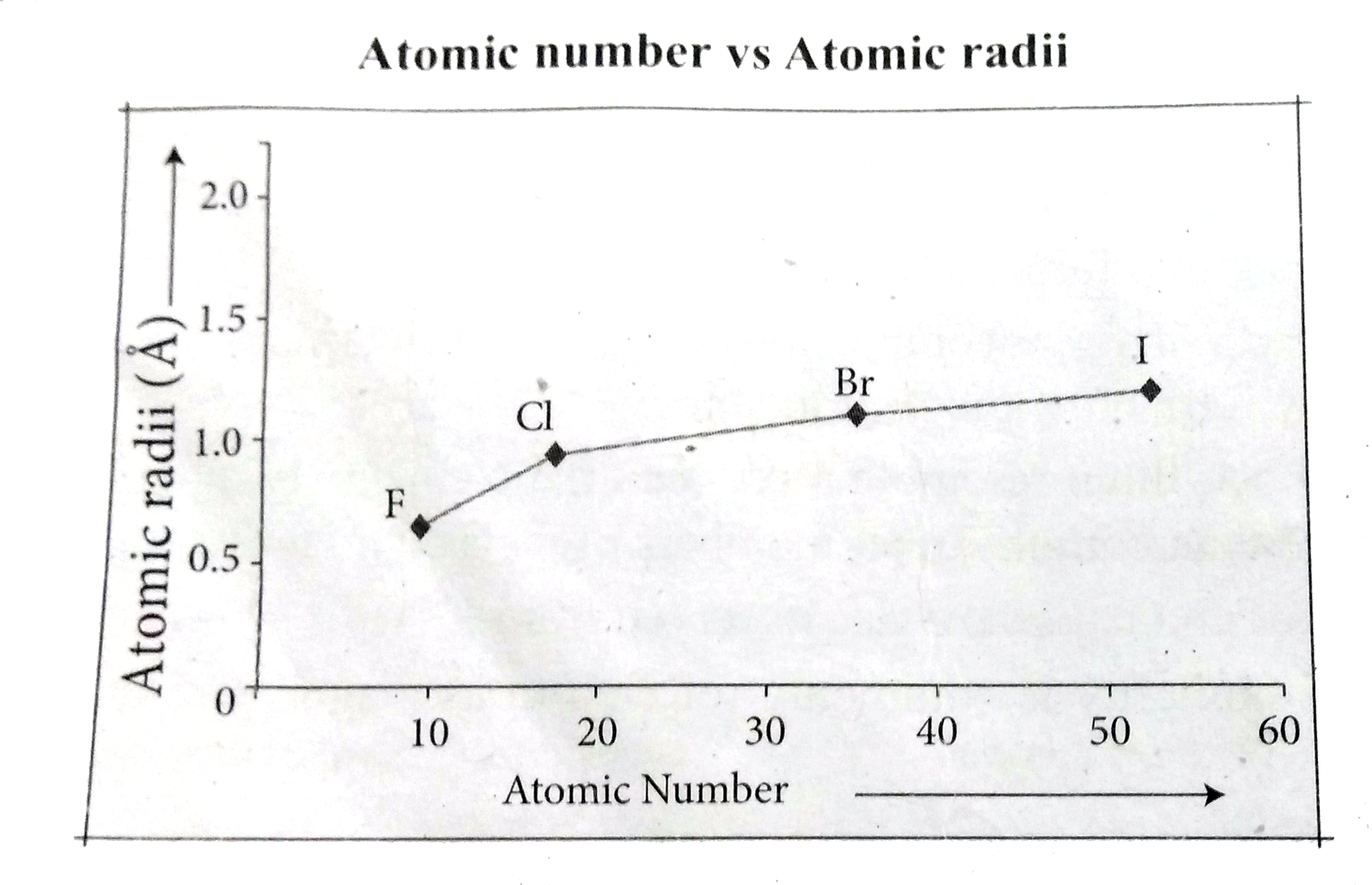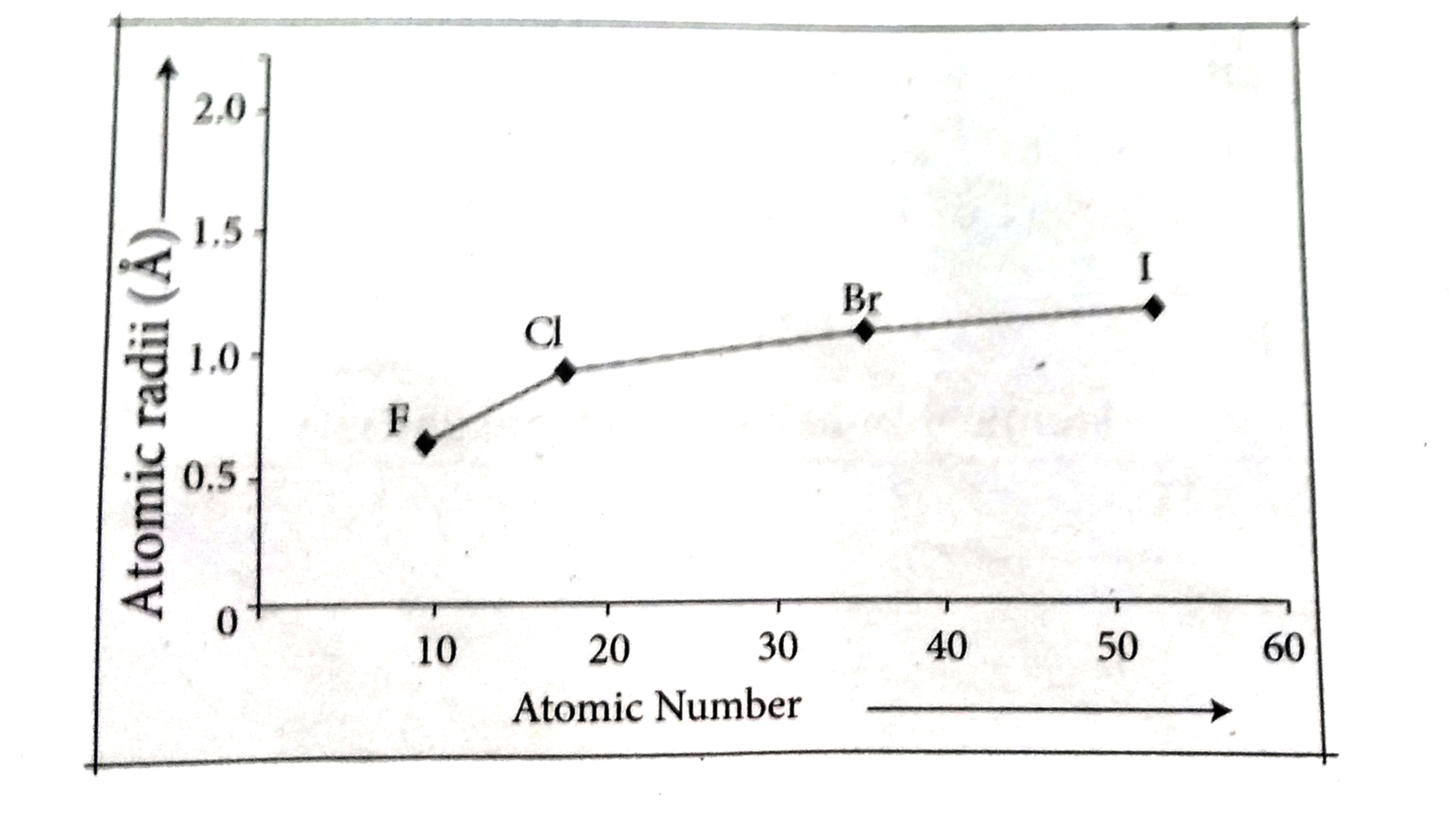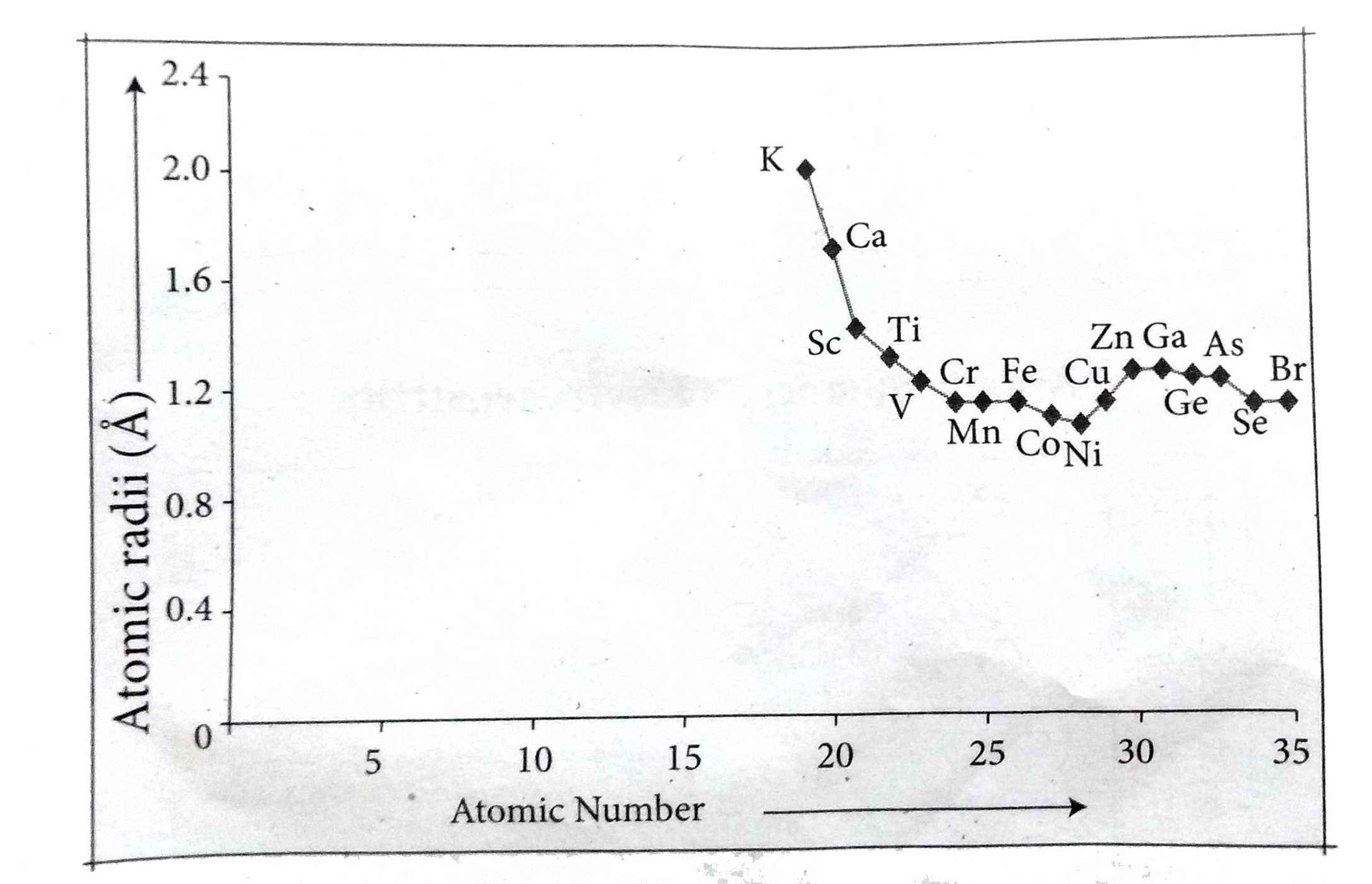Covalent radii (in A) for some elements of different groups and periods are listed below. Plot these values against atomic number. From the plot, explain the variation along a period and a group.
2nd group elements : Be (0.89), Mg (1.36), Ca (1.74), Sr (1.91) Ba(1.98)
17th group elements : F (0.72), CI (0.99), Br(1.14). T (1.33)
3rd Period elements : Na(1.57), Mg(1.36). AI (1.25), Si(1.17). P(1.10), S(1.04). C1(0.99)
4th period elements : K(2.03), Ca(1.74). Sc(1.44). Ti(1.32), V(1.22), Cr(1.17), Mn(1.17) Fe(1.17). Co(1.16). Ni(1.15). Cu(1.17). Zn(1.25), Ga(1.25). Ge(1.22). As(1.21). Se(1.14). Br(1.14)Solution in Tamil
2nd group elements :

17th group elements :

As we move down the group, atomic radii increase an increases with the increase in atomic number. As we move down the group, the number energy levels increases, as the number of CICUS increases. Each subsequent energy level is further from the nucleus than the last. Therefore the atomic radius increases as the group and energy level increases.
3rd period:

4th period:

As we move across the period, the atomic radii generally decreases with the increase in atomic number. This is due to the increase in nuclear charge. Across the period, the extra electrons are only added to the same quantum shell, as a result, the electron cloud contracts and the atomic radius decreases
Topper's Solved these Questions
- PERIODIC CLASSIFICATION OF ELEMENTS Book:FULL MARKSChapter:PERIODIC CLASSIFICATION OF ELEMENTS Exercise:Activity 3.2
Explore 1 Video
- PERIODIC CLASSIFICATION OF ELEMENTS Book:FULL MARKSChapter:PERIODIC CLASSIFICATION OF ELEMENTS Exercise:Higher Order Thinking skills (HOTS) Questions
Explore 10 Videos
- HYDROGEN Book:FULL MARKSChapter:HYDROGEN Exercise:Additional Questions Solved 5-Mark Questions
Explore 10 Videos
- PHYSICAL AND CHEMICAL EQUILIBRIUMBook:FULL MARKSChapter:PHYSICAL AND CHEMICAL EQUILIBRIUMExercise:ADDITIONAL QUESTIONS SOLVED (NUMERICAL PROBLEMS)
Explore 3 Videos
Similar Questions
The electronegativity for some elements on pauline scale of different groups and periods are listed below. Plot these values against atomic number. From the pattern, explain the variation along a period and a group.
2nd group elements : Be (1.6), Mg (1.2). Ca (1.0), Sr (1.0) Ba(0.9)
17th group elements : F (4.0), CI (3.0), Br (2.8). I (2.5)
3rd Period elements : Na(0.9), Mg(1.2), AI (1.5), Si(1.8), P(2.1), S(2.5), CI(3.0)
4th period elements : K(0.8), Ca(1.0). Sc(1.3), Ti(1.5), V(1.6), Cr(16), Mn(1.5), Fe(1.8). Co(1.9), Ni(1.9). Cu(1.9). Zn(16), Ga(16), Ge(1.8), As(2.0), Se(2.4), Br(2.8)
View SolutionConsider the isoelectronic species Na+,Mg2+,F− and O2−.The correct order of increasing length of their radii is:
View SolutionExplain about the different industrial preparation of hydrogen.
View SolutionFind the value of Kc for each of the following equilibria from the value of Kp
(a) 2NOCl(g)⇔2NO(g)+Cl2(g),KP=1.8×10−2 atm at 500 K
(b) CaCO3(s)⇔CaO(s)+CO2(g),KP=167 atm at 1073 K
View SolutionArrange giving reason the following elements in increasing order of their atomic size :
(a) Be, O, F (Given that they beiong to 2nd, 16th and 17th groups respectively and to 2nd period).
(b) I, CI, F (Given that they belong to 5th, 3rd and 2nd periods respectively of 17th group).
(c) Mg, N, P (Given that Mg and P belong to 2nd and 15th group respectively of 3rd period and N belongs to 15th group of 2nd period).
View Solutionतत्त्व Mg आवर्त-सारणी के द्वितीय समूह में है। यदि Mg का तुल्यांक भार 12 है, तो तत्त्व का परमाणु भार ज्ञात कीजिये।
View SolutionGroup : Be - Mg -Ca -Sr -Ba -Ra
Period : Na -Mg -Al - Si - S -Ci -Ar
Write the order of increasing or decreasing in the given boxes .

View SolutionThe electronegativity for some elements on pauline scale of different groups and periods are listed below. Plot these values against atomic number. From the pattern, explain the variation along a period and a group. 2^nd group elements : Be (1.6), Mg (1.2). Ca (1.0), Sr (1.0) Ba(0.9) 17^(th) group elements : F (4.0), CI (3.0), Br (2.8). I (2.5) 3^rd Period elements : Na(0.9), Mg(1.2), AI (1.5), Si(1.8), P(2.1), S(2.5), CI(3.0) 4^th period elements : K(0.8), Ca(1.0). Sc(1.3), Ti(1.5), V(1.6), Cr(16), Mn(1.5), Fe(1.8). Co(1.9), Ni(1.9). Cu(1.9). Zn(16), Ga(16), Ge(1.8), As(2.0), Se(2.4), Br(2.8)
View SolutionAn element "X" belongs to group "15" and "2"nd period in the periodic table the atomic number of elements is
View SolutionWhat is the atomic number of element of period 3 and group 17 of the Periodic Table?
View SolutionWhat is the atomic number of element of period 3 and group 17 of the Periodic Table?
View SolutionWhat is the atomic number of element of period 3 and group 17 of the Periodic Table?
View SolutionWhat is the atomic number of element of period 3 and group 17 of the Periodic Table?
View SolutionElements of a group and Elements of a period
View SolutionWhat is the atomic number of element of period 3 and group 17 of the Periodic Table?
View Solution

